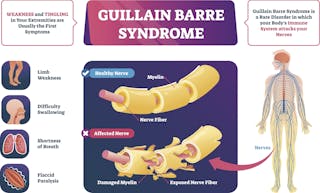Context
-
Johnson & Johnson’s beleaguered COVID-19 vaccine may be associated with a small increased risk of Guillain-Barré syndrome, a rare but potentially serious neurological condition. The Food and Drug Administration has added a warning about the potential side effect to its fact sheets about the vaccine.
What is Guillain-Barré Syndrome?
- It is a rare condition in which the body’s immune system attacks nerve cells.
-

Source: The Conversation It can cause muscle weakness and paralysis.
- It is most common in adults over 50.
- The exact cause of Guillain-Barre syndrome is unknown but two-thirds of patients report symptoms of an infection in the six weeks preceding which include respiratory or a gastrointestinal infection or Zika virus.
- There’s no known cure for Guillain-Barre syndrome, but several treatments can ease symptoms and reduce the duration of the illness.
What do we know about its connection to the COVID-19 vaccines?
- One hundred reports of the syndrome after vaccination with the Johnson & Johnson shot have been submitted to the federal Vaccine Adverse Event Reporting System (VAERS).
- The syndrome was generally reported about two weeks after vaccination, primarily in men, many of whom were 50 or older.
- There is not yet any data to suggest a link between the condition and COVID vaccines made by Pfizer-BioNTech or by Moderna.
What signs and symptoms should I look out for?
- The syndrome is most likely to appear within 42 days of vaccination, the FDA notes in its revised fact sheet for patients.
- You should consult with a doctor if you begin to experience weakness or tingling in your arms and legs, double vision or difficulty walking, speaking, chewing, swallowing, or controlling your bladder or bowels.
Back to Basics
Types of Guillain-Barré Syndrome
- Acute inflammatory demyelinating polyradiculoneuropathy (AIDP): It is the most common form in North America and Europe.
- The most common sign of AIDP is muscle weakness that starts in the lower part of your body and spreads upward.
- Miller Fisher syndrome (MFS): It is a type in which paralysis starts in the eyes.
- MFS is also associated with unsteady gait and is less common in the U.S. but more common in Asia.
-
Acute motor axonal neuropathy (AMAN) and acute motor-sensory axonal neuropathy (AMSAN): They are less common in the U.S. but they are more frequent in China, Japan and Mexico.
Social Justice Current Affairs : Click here
